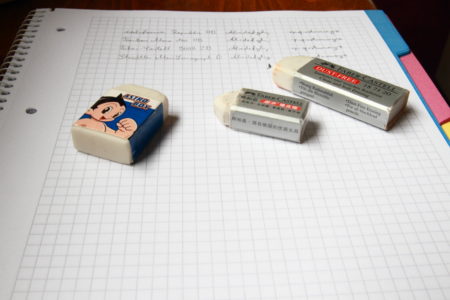Writing slates
When I started school and we learned how to write we were using writing slates, probably because you can practise again and again without wasting paper. They were not really made of slate, instead they were a bit like a laminated piece of paper, just that the plastic used is much harder and that the surface was not smooth. A few months ago I found my old writing slate again, together with the sponge to clean it and the pencil to write on it.
The sponge came in a container that could be closed – nice when you want to transport it, but not nice if you do not let the sponge dry out from time to time, as the old water will get smelly. The pencil was a “Heft und Tafel” (exercise book and chalkboard) pencil from A.W. Faber-Castell. As the name suggests they can be used on slate and on paper. You can still get the “Heft and Tafel” pencils today. I bought the white Goldfaber pencil you can see in the photo in April 2010 from Bürobedarf Jäcklein in Volkach for € 1 (~$ 1.38; ~85p). Even the writing slate Scolaflex is still available from Brunnen. Mine is from the late Seventies, just like the blue pencil. It has lines on one side to help getting the cap height and baseline right and is plain dark green on the other side.
Writing slates from proper slate are still available for a reasonable price. I just bought this school writing slate (see photo) from Inigo Jones for £ 3.25 (~$ 5.25; ~€ 3.80). It even comes with a slate pencil. Unfortunately I was not able to find out whether the slate is real Welsh slate.
Price: April 2010, Exchange rates: November 2010
Lexikaliker has a nice photo of a writing slate (Google translation) .












